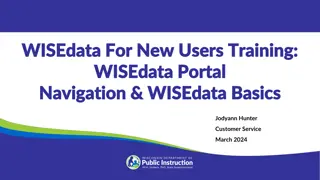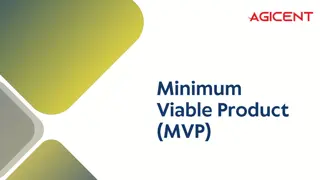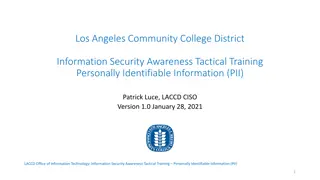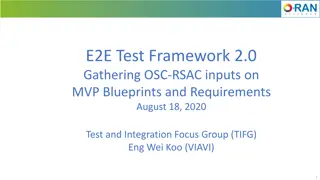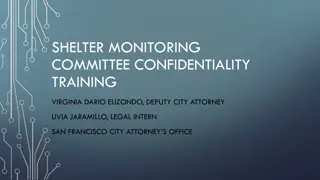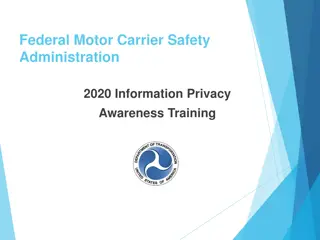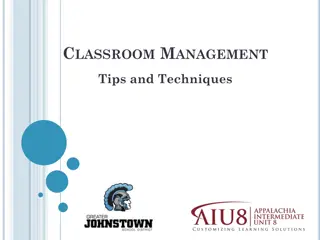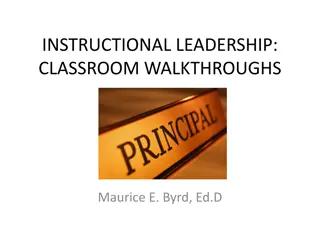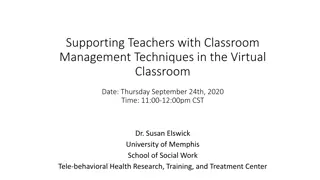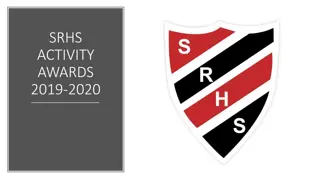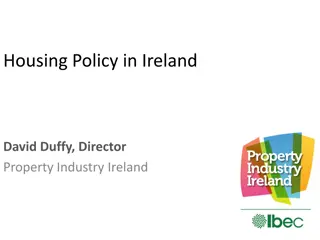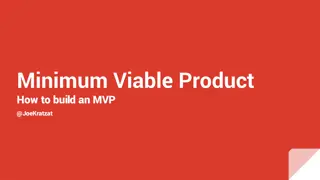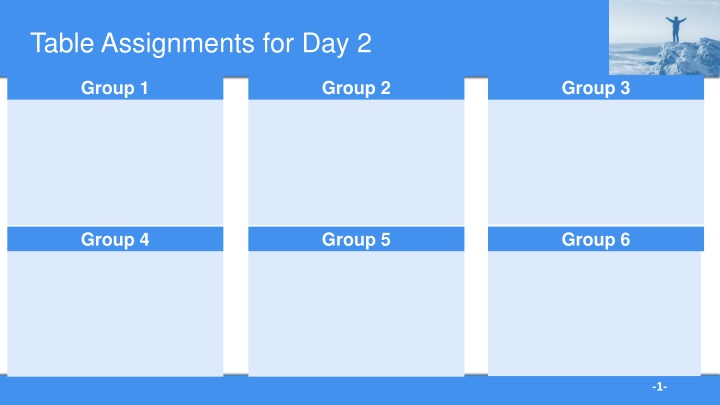
Professional Development Program - Digital Services Contracting Insights
Explore the professional development program focusing on digital services contracting, including assignments, logistics, announcements, and learning objectives. Gain insights into understanding digital services, stakeholder analysis, acquisition strategies, and vendor evaluation methods.
Download Presentation

Please find below an Image/Link to download the presentation.
The content on the website is provided AS IS for your information and personal use only. It may not be sold, licensed, or shared on other websites without obtaining consent from the author. If you encounter any issues during the download, it is possible that the publisher has removed the file from their server.
You are allowed to download the files provided on this website for personal or commercial use, subject to the condition that they are used lawfully. All files are the property of their respective owners.
The content on the website is provided AS IS for your information and personal use only. It may not be sold, licensed, or shared on other websites without obtaining consent from the author.
E N D
Presentation Transcript
Table Assignments for Day 2 Group 1 Group 2 Group 3 Group 4 Group 5 Group 6 -1- -1-
Digital Services Contracting Professional Development MVP Program Release 2 Classroom Session October 2016 -2-
Logistics for the Next Four Days Room is open from 7:30 a.m. to 4:00 p.m. every day note this likely means we will need to wrap up around 3:45 p.m. Class is from 8:00 a.m. 4:00 p.m. Assigned seating each day for you to meet participants outside your LDA team Internet access Restrooms Student lounge with laptops and printer Full kitchen to store your lunch, grab water and coffee -3- -3-
Announcements Badging is back up for 1.B, 2.A, and 2.B in the portal Complete your Iteration Completion Checks in the left navigation under each iteration to get issued badges some of you could have done this before the site went down in which case you will already have a badge Reminder to do research based on MAP case assignment for tomorrow this will be the focus of the morning We will also be discussing your stakeholder analysis later this morning so make sure that s handy Dinner this week -4- -4-
Where Youve Been Understanding what digital services is, how digital services is executed, and the current role of a government digital services professional A scan of the digital services market potential sources of supply and how to communicate with them pre-solicitation Release 1 Digital Services in 21st Century Government Exploring the need or outcome you re trying to achieve with what you re buying Identifying and partnering with key stakeholders who will impact your acquisition Conducting market research and preparing to develop your acquisition strategy Release 2 Understanding What You re Buying -5- -5-
Where Youre Going How to effectively acquire digital service The acquisition strategy Use of Lean Canvas tool Pricing Evaluation methods and criteria The solicitation package Release 3 How Do You Buy? Release 4 Awarding & Administering Digital Service Contracts Evaluate vendors who deliver digital services using metrics on project health, developed via lean thinking and agile development methods -6- -6-
Day 2 Agenda Day 2 Classroom Session Introduction and Icebreaker Brief Review of Release 1 The Importance of Understanding Stakeholder Challenges Morning LUNCH The Importance of Understanding Stakeholder Challenges (Part II) Live Digital Assignment Group Work Afternoon -7- -7-
Orientation Agenda Day 3 Day 4 Day 5 Influencing conversations roleplays Review of Salesforce Market Research Study MAP Case Study Review Beyond the RFI Release 3 Introduction to the Acquisition Strategy Lean Canvas Introduction Morning Morning Morning LUNCH LUNCH LUNCH Market Research Case Study Recap Guest speakers: The Vendor Perspective on Doing Business with Government VA Guest Panel Implementing an Acquisition Strategy in an innovative way Afternoon LDA Report Out and Reflection Classroom Session Conclusion Afternoon Afternoon -8- -8-
Activity Instructions Activity Instructions Your group represents a private research and development company that is helping to build a biodome in Arizona In the design phase you must work with your group to select targets for your biodome across three factors: Construction time Number of building pieces used Height of the model In the construction phase, your model must remain freestanding for at least 2 minutes to qualify for scoring At the end of the exercise, groups that have met all their targets will be compared The group that has the most points will be considered the most successful If there is a tie, the group that has assembled its prototype in the least amount of time will win -10- -10-
Design Phase You will have 10 minutes to identify your targets for each factor Note that you may receive bonus points for exceeding your targets You will be disqualified if your biodome does not meet your projected targets Review the target scoring sheet and decide on targets for the following factors: Number of pieces the biodome design requires (fewer pieces = less maintenance/overhead = more points) Time required for assembly of the biodome (faster = better readiness factor in crisis = more points); and Height of the biodome (taller = better ability to get solar energy = more points) -11- -11-
Construction Period Now you will have up to 10 minutes to construct your model. Remember the compliance requirements to avoid being disqualified. When you finish assembling your biodome, all team members must alert me or the co-facilitator of your completion by stepping away from the biodome and raising your hands in the air. One of us will shout out the time it took you to complete your tower; write it down in your Learner Guide -12- -12-
Additional Requirement You must incorporate a roll of Post-Its into your biodome The Post-Its cannot be touching the table The clock will reset at 10 minutes -13- -13-
Biodome in Arizona Debrief What did your team do that worked well? What did your team do that did not work well? What concepts from this activity apply to the Digital Acquisition MVP? What types of influencing strategies did you use in either the design or construction phase? If we were to apply this to your live digital assignments, at what phase are you right now? -14- -14-
Pre-Program and Release 1 Assessment Results -15-
Assessment Approach Why assessments? To give you feedback that can guide your program efforts To enable continuous program customization So far, you have participated in: Pre-Program Assessment Eight scenarios and 51 multiple choice items Release 1 Assessment 28 multiple choice items -16- -16-
Pre-Program Assessment: Cohort Overview Release Mean Percent Score by Objectives Best performance on Release 3 questions 80.00% 68.1% 70.00% 64.4% 60.3% 57.1% 60.00% The lowest scores were for Release 4 questions Wide range of scores on this Release 50.00% 40.00% 30.00% 20.00% 10.00% 0.00% Release 1 Release 2 Release 3 Release 4 -17- -17-
Pre-Program Assessment: Performance Objectives Strongest Performance Objectives Objective 1.3: Identify modern design, development, and delivery methods used by digital services professionals Objective 1.4: Identify who s who in the digital services arena, including public and private sector organizations and individuals Weakest Performance Objectives Objective 4.5: Identify software engineering practices for high-quality digital services like version control, continuous integration, and continuous delivery Objective 2.5: Identify why communicating openly and responsibly with potential vendors is critical to digital services acquisition success and how to do it -18- -18-
Release 1 Assessment: Cohort Overview Release 1 Assessment Mean Scores by Objective Overall cohort mean score: 60% Average of 15.68/28 items correct Strongest Performance Objective 1.4: Identify who s who in the digital services arena Weakest Performance Objectives 1.7: Identify the high-level principles of agile development 1.8: Describe what sets agile methods apart Objective 1.1 59.3% Objective 1.2 74.5% Objective 1.3 71.4% Objective 1.4 81.1% Objective 1.5 67.5% Objective 1.6 64.8% Objective 1.7 56.9% Objective 1.8 56.8% 0.00 0.20 0.40 0.60 0.80 1.00 Series 1 -19- -19-
Comparing the Pre-Program and Release 1 Assessments Comparison of Cohort Pre-Program Assessment and Release 1 Scores for Release 1 Performance Objectives The greatest percentage of participants saw an increase in Objective 1.1 scores Objectives 1.3 and 1.4 were the strongest in the Pre-Assessment, meaning there was less room for improvement Performance Objective Score Increase Equal Score Score Decrease 41% 56% 4% 1.1 19% 59% 22% 1.2 0% 93% 7% 1.3 4% 89% 7% 1.4 Caution: The Pre-Assessment had fewer questions, so it may have been easier to receive a high score (as compared to Release 1). 19% 44% 37% 1.5 37% 30% 33% 1.6 26% 52% 22% 1.7 7% 78% 15% 1.8 -20- -20-
Tips Be patient. Don t let the perfect be the enemy of the good. -22- -22-
Before We Begin A couple of good questions -23- -23-
About Me President of Vidya (@VidyaSource) Over a decade of experience in software engineering with commercial and government clients Member of GAO Agile Expert Group and contributor to a GAO government report on agile Author and presenter Certified in stuff -24- -24-
Agenda Knowing the Stakeholders Agile Start to Finish Building Digital Services Using the Cloud -25- -25-
Agenda Knowing the Stakeholders Agile Start to Finish Building Digital Services Using the Cloud -26- -26-
The Product Owner The Play s the thing Responsibilities Empowered to make decisions for all stakeholders Responsible for the ROI Maintains product backlog and prioritizes features sprint to sprint Defines acceptance criteria and decides what passes -27- -27-
Other Stakeholders Development lead UX designers/UI developers Software engineers Database engineers Testers Deployment/automation engineers Security specialists -28- -28-
The Most Important Stakeholders The American people -29- -29-
Agenda Knowing the Stakeholders Agile Start to Finish Building Digital Services Using the Cloud -30- -30-
The Traditional Approach Plan-driven software development Plan developed early with heavy resources long before any software is built Speculates on where things will be in the future Updates to the plan tightly controlled and variance from the plan measured throughout Success measured by limiting variance Phased gate model Based on the Triple Constraint with fixed scope -31- -31-
Dont Go Chasing Waterfall Ill-suited for creative work Plan obsolescent before it s even finished Resistance to scope creep Phase-gate approach antithetical to optimizing flow Gold plating -32- -32-
A Lot of Waste Often or Always Used: 20% Sometimes 16% Rarely 19% Never 45% Often 13% Always 7% Rarely or Never Used: 64% Software features built the traditional way -33- -33-
Benefits of an Agile Approach JEDUF replaces BDUF Smarter planning Only the highest-priority scope elements developed Frequent customer feedback after short, fixed iterations Automation and metrics Continuous adjustments to scope based on evolving business needs Fail fast Collective code ownership Consistent delivery of working software -34- -34-
Agile Product Vision I believe this nation should commit itself to achieving the goal, before this decade is out, of landing a man on the moon and returning him safely to the Earth. -- President John F. Kennedy -35- -35-
Agile Product Vision Formats Elevator Pitch Product Datasheet Product Vision Box User Conference Slides Press Release Magazine Review -36- -36-
High-Level Product Backlog Comprised of high-level user stories called epics Typically created by the same people who created the Product Vision Driven and prioritized by the Product Owner Continuously updated throughout the project -37- -37-
User Stories Redux Convenient format for briefly representing business value in business terms 3 C s Card Conversations Confirmation As a wiki user, I want to upload files so I can share them with colleagues. -38- -38-
Product Roadmap Series of goal-oriented releases for achieving the Product Vision Frequent, incremental deployments of Minimum Releasable Features Decided by stakeholders Must meet functional and quality expectations Periodic release strategy simplest High-level technological concerns important Continuously updated -39- -39-
Lean Thinking Discipline offering the conceptual underpinnings of agile development Key concepts MVP Validated learning Actionable metrics vs. vanity metrics -40- -40-
Lean Software Development Eliminate waste Amplify learning Decide as late as possible Deliver as fast as possible Empower the team Build integrity in See the whole -41- -41-
Agile Principles Defined by the signatories to the Agile Manifesto -42- -42-
Kanban Meta-process heavily influenced by Lean Thinking Key principles Visualize work Limit work in process Manage flow Little s Law: Cycle time = WIP/Throughput Ideal for high-interrupt work and generic workflows but certainly applicable to application development -43- -43-
Scrum Formalized process with a prescriptive approach to applying lean principles Best suited to application development Ceremonies Sprint Planning Meeting Daily Standup Review and Retrospective Roles Product Owner (Play 6) ScrumMaster Delivery Team (Play 7) -44- -44-
Not Everything Is A Nail When not to go agile Software installations with minimal customization Straightforward data migrations Otherwise Scrum for application development and Kanban for generic workflows -45- -45-
Why It Matters Digital Service Playbook Assessing vendor understanding of lean and agile concepts pre- award Delivering value Eliminating waste Evaluating vendor approaches Defining the boundaries for lead/cycle time Agreement among stakeholders on when the clock starts Definition of Done -46- -46-
Agile Metrics Amplify learning Fail fast -47- -47-
Core Agile Metrics Lead/cycle time Throughput Cumulative flow Bugs (number, type, severity) Scrum Metrics we already know Story points Burndown Velocity Potential flaws Relative Administrative burden #NoEstimates -48- -48-
Sources for Metrics Project tracking system Source control Build pipeline System monitoring -49- -49-
Why It Matters Digital Services Playbook plays 4, 7, 9-12 Immediate understanding of project health Pre-award evaluation of vendor maturity Metrics and automation awareness Willingness for scrutiny Distinguishing bugs and avoiding recidivism Delivery speed Post-award Identifying barriers to productivity Stakeholder pressure Absence of Product Owner Staffing issues Fail fast Building trust through transparency and continuous delivery Transition plan Process metrics vs. Product metrics -50- -50-


